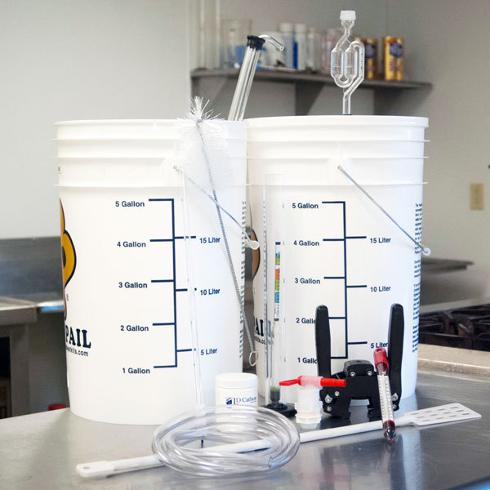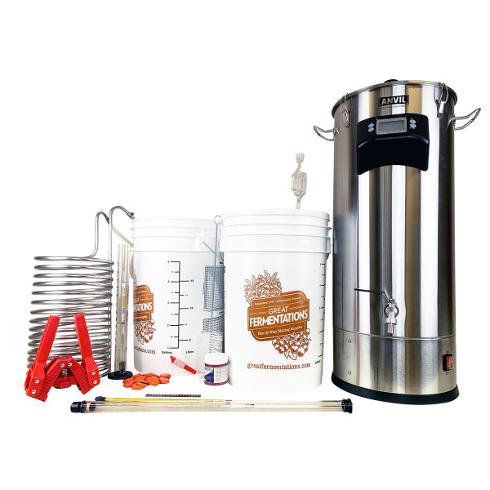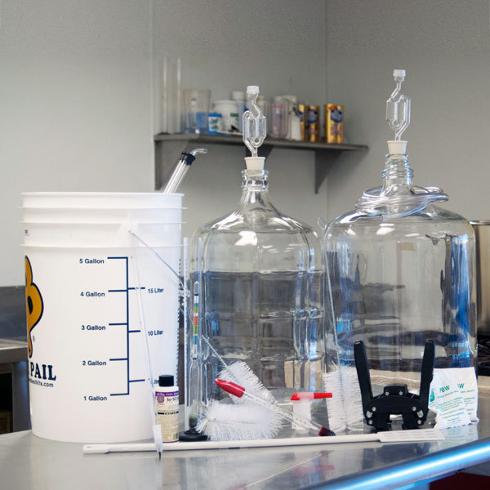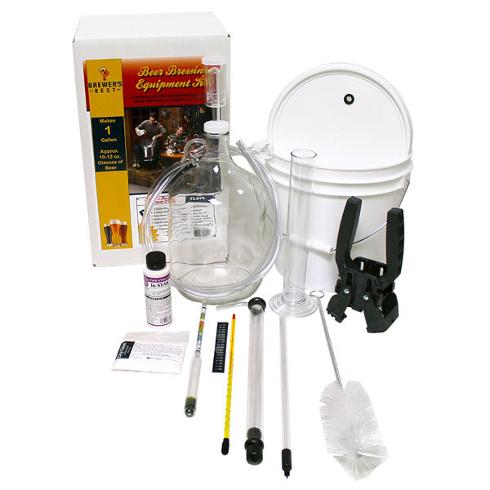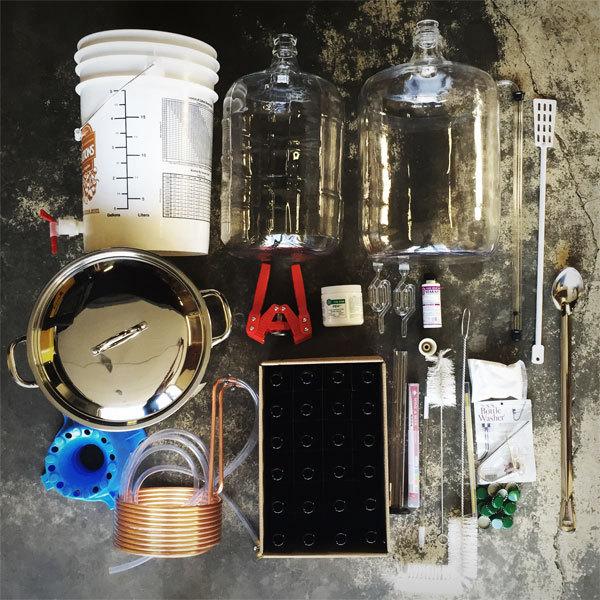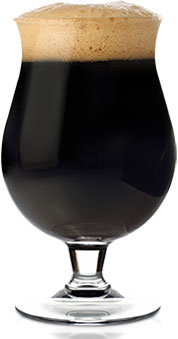
Hello, and welcome again to Brew Along With Us! This month, I'll be looking at a beer style that has come into popularity over the course of the last few years. I am talking about what has become known as an American-style India Black Ale, although you may have heard of this referred to as a black IPA or a Cascadian Dark Ale. By any name, it is an interesting, up-and-coming beer style that has its die-hard fans.
Whatever your preferred name, this beer shares a few similarities with other beer styles. It has the hop character and alcohol content of an IPA or one of its stronger relatives. In terms of color, a Cascadian dark should resemble a porter or a stout, ranging anywhere from a dark brown or ruby to jet black in appearance.
Some may be tempted to take a porter or a stout and simply hop it up. However, you would be off the mark.. Porters and stouts have a richness and go heavy on robust roasted notes. The black IPA should actually finish dry with a bit of a roasted note that should not be as pronounced as in porters or stouts €“ enough so that you wouldn't mistake it for an IPA if you were drinking it blindfolded. This is often accomplished with debittered or dehusked black malts. In my research, I have found that brewers may also incorporate these malts in different ways to avoid some of the astringency, such as putting the grains in near the end of the mash or cold steeping the grains to get color only. Other dark malts may be used as well, but the normal heavy roasted character that comes with the use of roasted barley or chocolate malt should largely be avoided. The focus should be on those glorious hops!
In my black IPA recipe (which is my first of the style, I admit) I am going with a fairly straightforward grain bill: 2-row, munich and light crystal, with Carafa II to provide color. Hopping follows a fairly normal IPA schedule and uses northwest American hops (one of the arguments of using the name Cascadian Dark Ale is that most of the ingredients should come from that region). And to ferment, a Northwest Ale strain of yeast.
There you have it! As always, let us know what you think or what you are doing with the recipe, we'd love to know! Cheers!
Fall Black IPA Recipe (for final volume of 5.5 gallons)
Specs
Estimated O.G. = 1.066
Estimated F.G. = 1.015
Estimated ABV = 6.7%
Estimated bitterness = 60 IBUs
Grain Bill
11 lbs.
2-Row Brewer's malt
1 lb.
Munich malt
1 lb.
Crystal 20L malt
1 lb.
Carafa II malt
Hops
1 oz.
Simcoe hops (12.7% AA), added at the beginning of the 60 minute boil
1 oz.
Citra hops, added with 15 minutes left in the boil
1 oz.
Amarillo hops, added with 5 minutes left in the boil
1 oz. each
Simcoe and
Citra hops, dry hop for 3 days.
Yeast
2 packs (or make an appropriate starter)
Wyeast 1332 Northwest Ale yeast, or 1.5 packs
Safale S-05 American Ale yeast
Brewing Process
- Perform a single infusion mash at 150F for 60 minutes. If you wish, leave the dark grains out of the mash and add in the last 10 minutes of the mash or just before sparging.
- Chill to 66F, pitch yeast and ferment for two weeks at 66F.
- Once primary fermentation is complete, either add hops to primary or transfer to secondary and add hops. The dry hop contact time should be relatively short. I prefer to dry hop for only 3 days. Once dry hopping is complete, keg or bottle as usual.
Extract Version: Replace the 2-Row Brewer's malt with 7.5 lbs. of
light dry malt extract. Steep the specialty grains (Munich malt, Crystal 20L and Carafa II) at 150-155F for 30 minutes using a
muslin grain bag. Remove the bag, allowing the grains to drain into the boil kettle. Turn off the flame and dissolve the extracts in the kettle. Turn the flame back on, bring to a boil and proceed as normal.
 Hello, and welcome again to Brew Along With Us! This month, I'll be looking at a beer style that has come into popularity over the course of the last few years. I am talking about what has become known as an American-style India Black Ale, although you may have heard of this referred to as a black IPA or a Cascadian Dark Ale. By any name, it is an interesting, up-and-coming beer style that has its die-hard fans.
Whatever your preferred name, this beer shares a few similarities with other beer styles. It has the hop character and alcohol content of an IPA or one of its stronger relatives. In terms of color, a Cascadian dark should resemble a porter or a stout, ranging anywhere from a dark brown or ruby to jet black in appearance.
Some may be tempted to take a porter or a stout and simply hop it up. However, you would be off the mark.. Porters and stouts have a richness and go heavy on robust roasted notes. The black IPA should actually finish dry with a bit of a roasted note that should not be as pronounced as in porters or stouts €“ enough so that you wouldn't mistake it for an IPA if you were drinking it blindfolded. This is often accomplished with debittered or dehusked black malts. In my research, I have found that brewers may also incorporate these malts in different ways to avoid some of the astringency, such as putting the grains in near the end of the mash or cold steeping the grains to get color only. Other dark malts may be used as well, but the normal heavy roasted character that comes with the use of roasted barley or chocolate malt should largely be avoided. The focus should be on those glorious hops!
In my black IPA recipe (which is my first of the style, I admit) I am going with a fairly straightforward grain bill: 2-row, munich and light crystal, with Carafa II to provide color. Hopping follows a fairly normal IPA schedule and uses northwest American hops (one of the arguments of using the name Cascadian Dark Ale is that most of the ingredients should come from that region). And to ferment, a Northwest Ale strain of yeast.
There you have it! As always, let us know what you think or what you are doing with the recipe, we'd love to know! Cheers!
Hello, and welcome again to Brew Along With Us! This month, I'll be looking at a beer style that has come into popularity over the course of the last few years. I am talking about what has become known as an American-style India Black Ale, although you may have heard of this referred to as a black IPA or a Cascadian Dark Ale. By any name, it is an interesting, up-and-coming beer style that has its die-hard fans.
Whatever your preferred name, this beer shares a few similarities with other beer styles. It has the hop character and alcohol content of an IPA or one of its stronger relatives. In terms of color, a Cascadian dark should resemble a porter or a stout, ranging anywhere from a dark brown or ruby to jet black in appearance.
Some may be tempted to take a porter or a stout and simply hop it up. However, you would be off the mark.. Porters and stouts have a richness and go heavy on robust roasted notes. The black IPA should actually finish dry with a bit of a roasted note that should not be as pronounced as in porters or stouts €“ enough so that you wouldn't mistake it for an IPA if you were drinking it blindfolded. This is often accomplished with debittered or dehusked black malts. In my research, I have found that brewers may also incorporate these malts in different ways to avoid some of the astringency, such as putting the grains in near the end of the mash or cold steeping the grains to get color only. Other dark malts may be used as well, but the normal heavy roasted character that comes with the use of roasted barley or chocolate malt should largely be avoided. The focus should be on those glorious hops!
In my black IPA recipe (which is my first of the style, I admit) I am going with a fairly straightforward grain bill: 2-row, munich and light crystal, with Carafa II to provide color. Hopping follows a fairly normal IPA schedule and uses northwest American hops (one of the arguments of using the name Cascadian Dark Ale is that most of the ingredients should come from that region). And to ferment, a Northwest Ale strain of yeast.
There you have it! As always, let us know what you think or what you are doing with the recipe, we'd love to know! Cheers!




